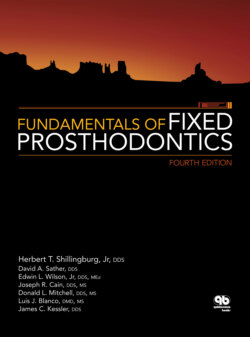Читать книгу Fundamentals of Fixed Prosthodontics - James C. Kessler - Страница 80
Mounting the mandibular cast
ОглавлениеThe incisal guide pin is extended 1 to 2 mm to compensate for the thickness of the interocclusal wax record. The centric lock is tightened on each enclosed condylar track mechanism to ensure that the articulator is capable of only a hinge opening.
Fig 5-67 The mandibular cast is held steady in the wax record while the mounting stone sets.
The articulator is inverted on the bench, resting on the three thumb nuts protruding from the upper member of the articulator. The centric relation interocclusal wax record is placed on the teeth of the maxillary cast. The teeth must seat completely into the wax record.
The mandibular cast is placed into the interocclusal record, and complete seating is again confirmed. There should be no contact between the maxillary and mandibular casts. The mandibular cast is removed and soaked for about 2 minutes. To prevent any erosion of the teeth on the cast, they must not be covered by water. The soaked mandibular cast is reseated into the record. The lower member of the articulator is swung up and back. A mound of thick, creamy mounting stone is placed on the bottom of the cast. Enough is applied to the mounting plate on the lower member to fill the cutout slots on either side of it. The lower member of the articulator is hinged back over into the soft mounting stone. The incisal guide pin should be resting firmly against the incisal guide table. A hand is used to steady the mandibular cast in the retruded position wax registration until the mounting stone has achieved an initial set (Fig 5-67).
The articulated casts are inspected for the following criteria:
The condyle is in the retruded position in its condylar track mechanism.
Both casts are seated completely in the interocclusal wax record.
Mounting stone is securely attached to both casts and mounting plates.
After the mounting stone has achieved a final set, the accuracy of the mounting is corroborated. The articulator is opened, and the incisal guide pin is raised so that it will not touch the incisal table when the teeth are contacting. The interocclusal record is removed, and a 2-inch piece of no. 10 red-inked silk ribbon is placed between the posterior teeth on both sides. The teeth are tapped together lightly, producing red marks on the teeth where they contact in the retruded position.
The pieces of 28-gauge green wax are retrieved and carefully positioned on the teeth of the maxillary cast. If the cast mounting is correct, the red marks on the teeth will be visible through the perforations in the wax. If they are not visible, the procedure should be rechecked step by step and the error corrected.
The mounting plates are unscrewed, and the casts are removed from the articulator. The plates and attached mounting stone are soaked in water. More mounting stone is added wherever it is needed to fill voids between the casts and the mounting plates. The additional stone is smoothed as it sets to give it a neat appearance. Care should be taken not to leave any stone on the surface of the mounting plate that will contact the articulator frame. It has been said that sloppy cast mountings are not an indication of a poor operator; they are absolute proof.
